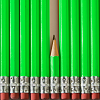Or search by topic
Number and algebra
Geometry and measure
Probability and statistics
Working mathematically
Advanced mathematics
For younger learners
Peeling the Apple or the Cone That Lost Its Head



First the headless cone :
If this sector had a radius of 10 units what would the area be?If the sector is made into a cone by closing up the gap, what will be the base radius for that cone?
If the cone now suffers a horizontal cut which removes the top and reduces the height of what remains to half the original cone height, what curved surface area does that lower shape now have?
Now for the Apple Peel :
Not a very healthy colour apple this one :Can you see that an apple can be approximated to a stack of "headless cones" ?
Not very tall ones!
And you could use that curved surface area calculation you did earlier to get an approximation for the total apple peel.
Maybe use a spreadsheet to get improved accuracy with more frustums (the name for headless cones!) ?
Anyway, what's the amount of peel on an apple whose diameter is 8cm?
You may also like

F'arc'tion
At the corner of the cube circular arcs are drawn and the area enclosed shaded. What fraction of the surface area of the cube is shaded? Try working out the answer without recourse to pencil and paper.

